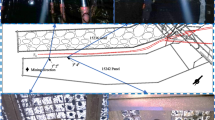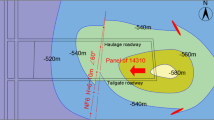Abstract
Study of movement characteristics of a hard–thick stratum (HTS) affected by a fault in a coalmine is significant to predict the dynamic hazards (i.e., rock bursts and shock bumps) because of the particular structural and mechanical properties of the HTS and the fault. Hence, using UDEC numerical simulation, the movement characteristic of HTS and fault-slipping law with different mining directions towards the fault were studied. Then, two different inducing modes and corresponding mechanisms of rock burst were obtained. The results show that the structure of overlying strata on two fault walls is different because of fault cutting and fault dip; it results in the HTS of two fault walls presenting different movement stage characteristics. From analysis of fault plane stress and fault slipping, we obtain that footwall mining has higher risk of rock burst than hanging wall mining. Finally, summarizing two different inducing modes of rock burst affected by the HTS and the fault: one that mainly resulted from the strain energy release caused by the HTS obvious bending and failure (i.e., hanging wall mining) and one that notably affected by fault slipping and HTS failure subsidence (i.e., footwall mining). A field case regarding microseismic monitoring is used to verify the numerical simulation results. Study results can serve as a reference for predicting of rock bursts and their classification into hazardous areas under similar conditions.
















Similar content being viewed by others
References
Alshkane YM, Marshall AM, Stace LR (2017) Prediction of strength and deformability of an interlocked blocky rock mass using UDEC. J Rock Mech Geotech Eng 9(3):531–542
Barton N, Choubey V (1977) The shear strength of rock joints in theory and practice. Rock Mech 10:1–54
Cao YX, He DD, Glick DC (2001) Coal and gas outbursts in footwalls of reverse faults. Int J Coal Geol 48(1–2):47–63
Hofmann GF, Scheepers LJ (2015) Simulating fault slip areas of mining induced seismic tremors using static boundary element numerical modeling. Trans Inst Min Metal 120(1):53–64
Itasca (2005) Universal distinct element code user’s guide (Version 4.0). Itasca Consulting Group, Minneapolis, USA
Ji HG, Ma HS, Wang JA, Zhang YH, Cao H (2012) Mining disturbance effect and mining arrangements analysis of near-fault mining in high tectonic stress region. Saf Sci 50(4):649–654
Jiang JQ, Wu QL, Qu H (2015) Characteristic of mining stress evolution and activation of the reverse fault below the hard-thick strata. J China Coal Soc 40(2):267–277 (Chinese)
Jiang LS, Sainoki A, Mitri HS, Ma NJ, Liu HT, Hao Z (2016) Influence of fracture-induced weakening on coal mine gateroad stability. Int J Rock Mech Min Sci 88:307–317
Jiang LS, Wang P, Zhang PP, Zheng PQ, Xu B (2017) Numerical analysis of the effects induced by normal faults and dip angles on rock bursts. C R Mec 345(10):690–705
Jiang JQ, Wang P, Jiang LS, Zheng PQ, Feng F (2018) Numerical simulation on mining effect influenced by a normal fault and its induced effect on rock burst. Geomech Eng 14(4):337–344
Jiang LS, Kong P, Shu JM, Fan KG (2019a) Numerical analysis of support designs based on a case study of a longwall entry. Rock Mech Rock Eng. https://doi.org/10.1007/s00603-018-1728-2
Jiang LS, Wang P, Zheng PQ, Luan HJ, Zhang C (2019b) Influence of different advancing directions on mining effect caused by a fault. Adv Civil Eng 2019:7306850
Li T, Mu ZL, Liu GJ, Du JL, Lu H (2016) Stress spatial evolution law and rockburst danger induced by coal mining in fault zone. Int J Min Sci Technol 26(3):409–415
Liu CY, Yetilmezsoy K, Zhang BS, Zhang S (2017) Fractural structure of thick hard roof stratum using long beam theory and numerical modeling. Environ Earth Sci 76(21):751
Lv JG, Jiang YD, Li SG, Ren SD, Jiang WZ, Zhang ZC (2014) Characteristic and mechanism research of coal bumps induced by faults based on extra thick and hard roof. J China Coal Soc 39(10):1961–1969
Ning JG, Wang J, Jiang LS, Jiang N, Liu XS, Jiang JQ (2017) Fracture analysis of double-layer hard and thick roof and the controlling effect on strata behavior: a case study. Eng Fail Anal 81:117–134
Qi QX, Dou LM (2008) Theory and technology of rockburst. China University of Mining and Technology press, Xuzhou, p 3
Rutqvist J, Rinaldi AP, Cappa F, Moridis GJ (2015) Modeling of fault activation and seismicity by injection directly into a fault zone associated with hydraulic fracturing of shale-gas reservoirs. J Petrol Sci Eng 127:377–386
Sainoki A, Mitri HS (2014a) Dynamic behaviour of mining-induced fault slip. Int J Rock Mech Min Sci 66C(1):19–29
Sainoki A, Mitri HS (2014b) Dynamic modelling of fault-slip with Barton’s shear strength model. Int J Rock Mech Min Sci 67(6):155–163
Sainoki A, Mitri HS (2014c) Methodology for the interpretation of fault-slip seismicity in a weak shear zone. J Appl Geophys 110:126–134
Sainoki A, Mitri HS (2015a) Influence of undulating fault surface properties on its seismic waves during fault-slip. Int J Min Reclam Environ 30(1):1–12
Sainoki A, Mitri HS (2015b) Evaluation of fault-slip potential due to shearing of fault asperities. Can Geotech J 52:1417–1425
Wang L, Cheng YP, Xu C, An FH, Jin K, Zhang XL (2013) The controlling effect of t hick-hard igneous rock on pressure relief gas drainage and dynamic disasters in outburst coal seams. Nat Hazards 66(2):1221–1241
Wang W, Cheng YP, Wang HF, Liu HY, Wang L, Li W, Jiang JY (2015) Fracture failure analysis of hard-thick sandstone roof and its controlling effect on gas emission in underground ultrathick coal extraction. Eng Fail Anal 54:150–162
Wang P, Jiang JQ, Zhang PP, Wu QL (2016) Breaking process and mining stress evolution characteristics of a high-position hard and thick stratum. Int J Min Sci Technol 26(4):563–569
Wang P, Jiang LS, Zheng PQ (2017) Application of equivalent materials to modeling fractures in the vicinity of a normal fault in the area of mining exploitation influence. Acta Geodynamica et Geomaterialia 14(4):475–485
Wang P, Jiang LS, Jiang JQ, Zheng PQ, Li W (2018a) Strata behaviors and rock burst–inducing mechanism under the coupling effect of a hard, thick stratum and a normal fault. Int J Geomech 18(2):04017135. https://doi.org/10.1061/(asce)gm.1943-5622.0001044
Wang P, Jiang LS, Li XY, Zheng PQ, Qin GP (2018b) Effects of strength weakening and interface slipping on rock mass with different dip angle structure planes. Acta Geodynamica et Geomaterialia 15(4):329–338
Wang P, Jiang LS, Li XY, Qin GP, Wang EY (2018c) Physical simulation of mining effect caused by a fault tectonic. Arab J Geosci 11(23):741. https://doi.org/10.1007/s12517-018-4088-z
Xia BW, Jia JL, Yu B, Zhang X, Li XL (2017) Coupling effects of coal pillars of thick coal seams in large-space stopes and hard stratum on mine pressure. Int J Min Sci Technol 27(6):965–972
Xu NW, Tang CA, Li LC, Zhou Z, Sha C, Liang ZZ, Yang JY (2011) Microseismic monitoring and stability analysis of the left bank slope in Jinping first stage hydropower station in southwestern China. Int J Rock Mech Min Sci 48(6):950–963
Zhao X, Lv JG (2015) Mechanical analysis of coal and rock dynamic instability by thick and hard roof thrust fault. Saf Coal Mines 46(1):198–201 (Chinese)
Zhou H, Meng FZ, Zhang CQ, Hu DW, Yang FJ, Lu JJ (2015) Analysis of rockburst mechanisms induced by structural planes in deep tunnels. Bull Eng Geol Env 74(4):1–17
Acknowledgements
The study was funded by the National Natural Science Foundation of China (nos. 51704182, 51804182), Tai’an Science and Technology Development Plan of Shandong Province (no. 2018GX0045), Shandong Provincial Natural Science Foundation (ZR2019BEE065), Scientific Research Foundation of Shandong University of Science and Technology for Recruited Talents (no. 2015RCJJ057), and Shandong Provincial Key R & D Plan (Public Welfare Special Program) of China (no. 2017GGX20125).
Author information
Authors and Affiliations
Corresponding author
Additional information
Publisher's Note
Springer Nature remains neutral with regard to jurisdictional claims in published maps and institutional affiliations.
Rights and permissions
About this article
Cite this article
Wang, P., Jiang, Ls., Zheng, Pq. et al. Inducing mode analysis of rock burst in fault-affected zone with a hard–thick stratum occurrence. Environ Earth Sci 78, 467 (2019). https://doi.org/10.1007/s12665-019-8448-0
Received:
Accepted:
Published:
DOI: https://doi.org/10.1007/s12665-019-8448-0




